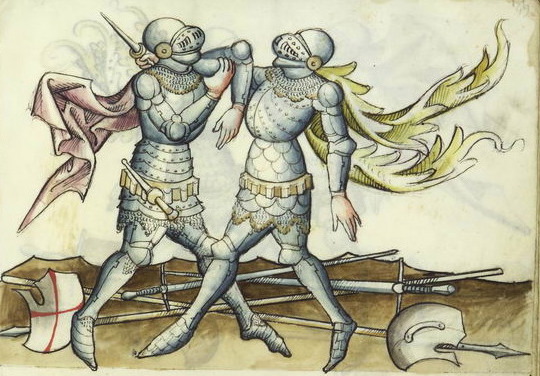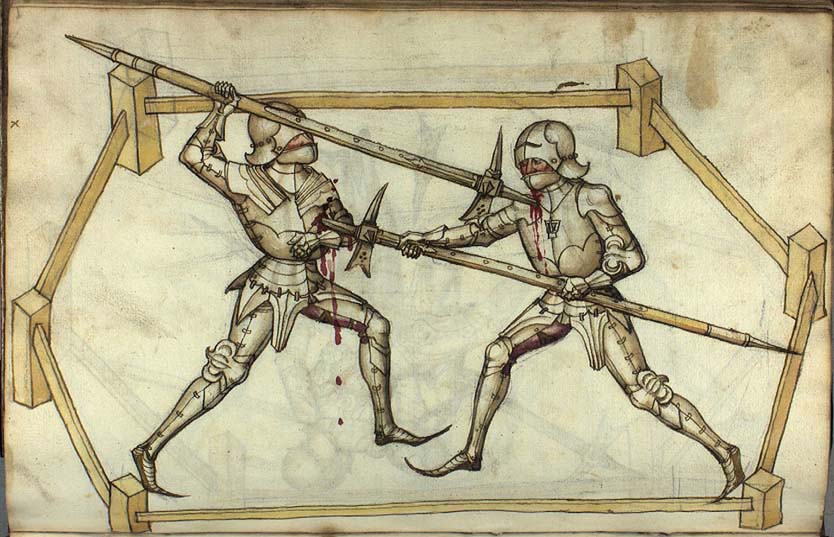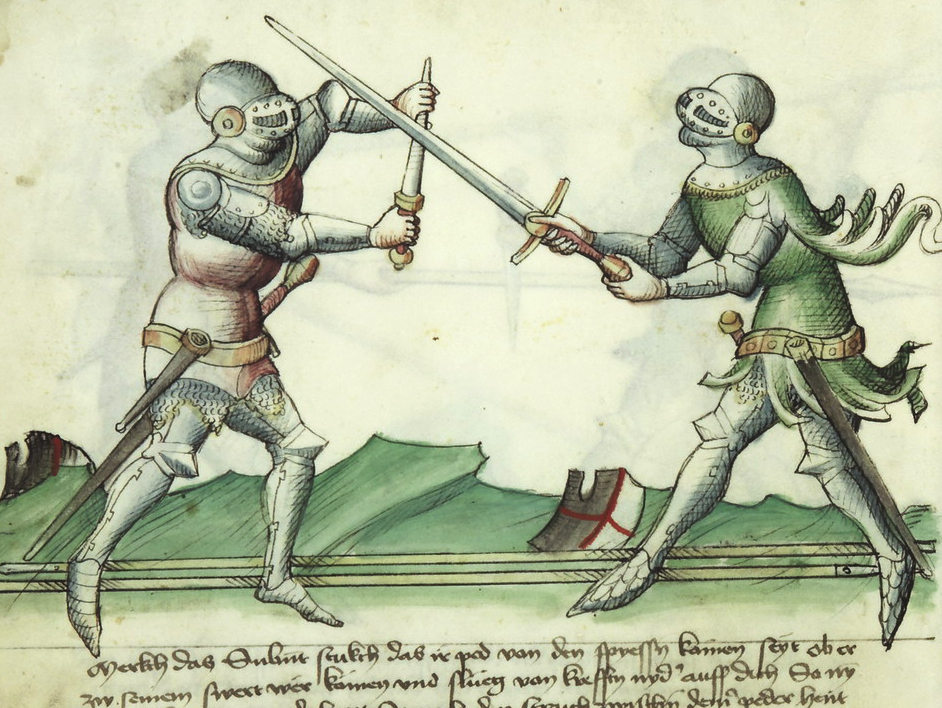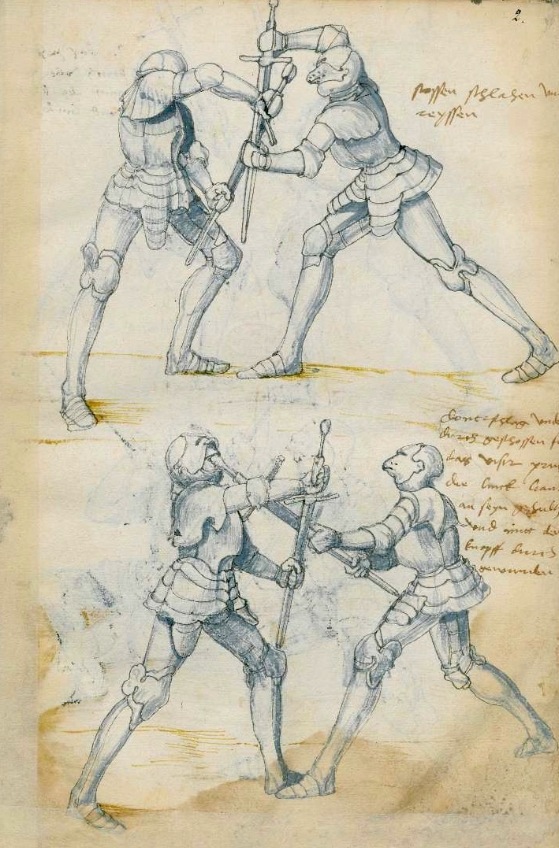 On the Practice of Armored Foot Combat On the Practice of Armored Foot Combat
Armored combat on foot can be one of the most challenging and
rewarding areas of historical fencing to engage in. It is also one of
the most problematic.
"Therefore it is manifest, that young soldiers should be furnished and fenced,
with all cunning and policy in fighting, and with all manner of armour and weapons.
For needs must he fight more boldly, that being safe of breast and head,
stands not in fear of wounding."
--John Sadle's Foure Bookes of Vegetius, 1572
By John Clements
ARMA Director
 Until
about the mid-16th century, fighting in armored plate harness made up
a significant portion of 14th and 15th century European martial arts literature.
Specific aspects of using the dagger, sword, spear, and poleax on foot
were all addressed in their teachings. A variety of specific sword types
were even optimized to deal with plate armor. There are many important
issues surrounding it that should be addressed and for which any serious
student of Renaissance martial arts should be aware. While the study of
armored combat is hardly my speciality, I understand how there is no way
to fully study Renaissance fighting disciplines without also exploring
the perfection that was European plate armor. Until
about the mid-16th century, fighting in armored plate harness made up
a significant portion of 14th and 15th century European martial arts literature.
Specific aspects of using the dagger, sword, spear, and poleax on foot
were all addressed in their teachings. A variety of specific sword types
were even optimized to deal with plate armor. There are many important
issues surrounding it that should be addressed and for which any serious
student of Renaissance martial arts should be aware. While the study of
armored combat is hardly my speciality, I understand how there is no way
to fully study Renaissance fighting disciplines without also exploring
the perfection that was European plate armor.
Functional
armor is so much more than mere costume, but today, few practitioners
of historical fencing have the opportunity to train in, let alone regularly
spar at length in, historically accurate armor. They seldom are able to
directly compare and contrast armored and unarmored fight teachings in
person. At one end of the spectrum there is practice of armored fighting
techniques while not wearing any armor, and at the other end there is
practice of armored combat solely for purposes of being able to go full-contact
with wooden or steel weapons (even if the armor worn is inaccurate and
the conditions applied highly artificial).
 The
source teachings from the martial arts of Renaissance Europe make it clear
that, naturally enough, unarmored fighting is the basis for armored harness
fighting. And it is certainly practical to study the basic distinctions
of armored combat today even while training unarmored. But this only works
to a degree --and historically it was never the standard manner of operating,
given that armor was so readily available to fighting men. The
source teachings from the martial arts of Renaissance Europe make it clear
that, naturally enough, unarmored fighting is the basis for armored harness
fighting. And it is certainly practical to study the basic distinctions
of armored combat today even while training unarmored. But this only works
to a degree --and historically it was never the standard manner of operating,
given that armor was so readily available to fighting men.
However, while
almost everything one can do unarmored, one can also do armored, there
are things that one can do in armor that one simply cannot do when
unarmored. Therefore, merely theoretically working through armored combat
teachings does not credibly approximate the experience of actually using
armor --let alone sparring both in and against it. On the one hand, you
can't properly simulate armored combat without wearing armor, but on the
other, inaccurate armor combined with poor understanding of the genuine
fight teachings can terribly mislead about its true nature.
In my view,
understanding armored combat skills requires, reasonably enough, for you
to use armor. You need to be familiar with wearing and moving in armor.
Because armor changes your center of gravity, it then changes something
of how you step and move, and how you strike and cover and ward. It also
changes not just the specific techniques that you can employ, but how
you can react to techniques. The more any armor deviates from the historical
pattern it's modeled after, the more these issues become manifest --and
the more these issues will distort your skill set. That this is not widely
appreciated among armored fighting enthusiasts is an unfortunate source
of problems for credibly reconstructing the craft (with the question of
specialized tournament armors being another matter entirely).
 If
you haven't trained and sparred at length while armored, both against
other armored fighters as well as against unarmored ones, can you really
know well enough what it's all about? Even then, it's not only a matter
of armored training and armored sparring, but in my view of also
using a sharp weapon in armor to practice target cutting to explore
how it again affects the motion of your limbs, your ability to step, to
apply force or momentum, and to keep balance. The way that helmets can
also restrict breathing, vision, and hearing cannot be ignored. If
you haven't trained and sparred at length while armored, both against
other armored fighters as well as against unarmored ones, can you really
know well enough what it's all about? Even then, it's not only a matter
of armored training and armored sparring, but in my view of also
using a sharp weapon in armor to practice target cutting to explore
how it again affects the motion of your limbs, your ability to step, to
apply force or momentum, and to keep balance. The way that helmets can
also restrict breathing, vision, and hearing cannot be ignored.
In armored
swordsmanship especially, it's critical to experience how the significant
change in mass and center of gravity influences everything having to do
with grip manipulation, edge alignment, impact focus, point control, follow-through,
and strike recovery. (And none of this even begins to address experimenting
to explore what real weapons could and would have actually done to damage
or penetrate different kinds of armors.)
 While
only the most ignorant today still believe the sad misconception that
wearing plate armor makes a fighting fighting man awkwardly slow and clumsy
or unable to get up when knocked down, there are other mistaken beliefs
that persist even among historical combat students. I guarantee that just
as with sparring or drilling, floryshing in armor is absolutely different
in terms of the demands it places on your energy, your respiration, and
your stamina, as well as your mindset, than does doing so unarmored. And
this is not to even consider the issue of rough terrain and uneven ground
in this. And the effect on weapon manipulation from wearing different
gauntlet configurations is another component entirely. Further, just how
significantly wearing armor affects the performance of grappling techniques
absolutely cannot be understood without practicing them in proper armor. While
only the most ignorant today still believe the sad misconception that
wearing plate armor makes a fighting fighting man awkwardly slow and clumsy
or unable to get up when knocked down, there are other mistaken beliefs
that persist even among historical combat students. I guarantee that just
as with sparring or drilling, floryshing in armor is absolutely different
in terms of the demands it places on your energy, your respiration, and
your stamina, as well as your mindset, than does doing so unarmored. And
this is not to even consider the issue of rough terrain and uneven ground
in this. And the effect on weapon manipulation from wearing different
gauntlet configurations is another component entirely. Further, just how
significantly wearing armor affects the performance of grappling techniques
absolutely cannot be understood without practicing them in proper armor.
It's not widely
understood that unless produced by an experienced and talented craftsman
dedicated to closely following historical examples, modern reproduction
armors are generally too thick, too soft, and typically attached improperly
to an incorrect undergarment. All of this will adversely affect the integrity
of performing the authentic combat actions. There really should not be
any doubt that wearing overly-heavy and improperly balanced armor with
modern under-padding for reasons of mock combat safety is a sure way to
misinterpret, if not outright misapply, the authentic historical combat
teachings.
 Obtaining
good armor today that is accurate in terms of material, mass, weight distribution,
articulation, and proper personal fit is problematic. Not to mention costly.
Most armored combat enthusiasts must make compromises in authenticity
for whatever study approach they have chosen to follow. This then influences
what they can do in their armor and what can be learned from doing it
(and in turn, influences the kind of feedback given to modern armorers!). Obtaining
good armor today that is accurate in terms of material, mass, weight distribution,
articulation, and proper personal fit is problematic. Not to mention costly.
Most armored combat enthusiasts must make compromises in authenticity
for whatever study approach they have chosen to follow. This then influences
what they can do in their armor and what can be learned from doing it
(and in turn, influences the kind of feedback given to modern armorers!).
Exploring
armored combat therefore requires a strong foundation in studying unarmored
fighting as well as considerable effort in safely drilling and practicing
in specialized anti-armor techniques. But unfortunately, it appears many
practitioners who focus exclusively on either full-contact armored sport
fighting or else on choreographed display routines will neglect these
important areas.
Probably the
most critical element to armored combat practice today is the realization
that there are many specialized techniques for dealing with fully armored
opponents (such as thrusting into the gaps and joints and delivering "reverse"
blows using the hilt of the sword) that cannot be safely used with steel
training blades because such techniques are just too dangerous to apply.
This is really no different than similar safety limitations and restrictions
that are regularly accepted for unarmored sparring and fighting practice
in general. But in the case of armor, because so many other actions are
"ineffective," the result of reasonably excluding the specialized "anti-armor"
techniques can then lead to false impressions about the nature of armored
combat.*
 I
eventually learned of my own false assumptions about armored fighting
the hard way through hands-on experience --or rather, to rephrase that:
I only learned the proper and historical way. I know that in decades past
I held major misconceptions about how historical armor functioned and
what combatants were actually capable of doing in it. And then I would
be wearing it and trying things and exclaiming, holy crap, you can't do
"X" in this. I would also come to realize that some particular strike
would assuredly have had zero effect against some portion of harness.
I would be hit by a blow and say, wow, I felt that even through the armor
--and that was from a blunt weapon no less. What if it had been
a sharp weapon delivered with proper force? I
eventually learned of my own false assumptions about armored fighting
the hard way through hands-on experience --or rather, to rephrase that:
I only learned the proper and historical way. I know that in decades past
I held major misconceptions about how historical armor functioned and
what combatants were actually capable of doing in it. And then I would
be wearing it and trying things and exclaiming, holy crap, you can't do
"X" in this. I would also come to realize that some particular strike
would assuredly have had zero effect against some portion of harness.
I would be hit by a blow and say, wow, I felt that even through the armor
--and that was from a blunt weapon no less. What if it had been
a sharp weapon delivered with proper force?
Very quickly
all of this experience informed my interpretation of the combat techniques
within the historical source teachings. It also seriously affected how
I examined authentic examples of harnesses in museums. I then became critical
of modern efforts at mock armored combat practice that, in the name of
making it recreationally viable, were making what I came to understand
were quite unrealistic assumptions about how armor worked in actual violence.
These are among the many reasons why I therefore try to view all Renaissance
arms and armor practice from a broad vantage point.
As a specialist
in unarmored combat who has long studied the original teachings on armored
fighting and who has worn and sparred in an assortment of armors (covering
a sadly disparate range of historical accuracy), I have a contrary opinion
on how legitimate some modern approaches to armored combat practice are.
Thus, whenever I encounter the assertion that practitioners training unarmored
are doing "traditional armored fighting", making certain assumptions about
postures, motions, and techniques that would be used against armored
opponents or while in armor, I have learned to be skeptical. Although
I do admire a host of modern armored-combat sport and re-enactment incarnations,
my interest and concern is decidedly on the historical teachings.
 I
know when I discuss or instruct on the fundamental unarmored techniques,
I am still constantly referring to how they would be different if attempted
"in armor" --and even then, in different types of armor (as well as if
with different types of swords and "anti-armor" weaponry). When it comes
to covering specific armored combat teachings while being unarmored, there
is a whole world of caveats and exceptions to cover so that students have
a proper perspective. If that's not addressed, then I am not impressed. I
know when I discuss or instruct on the fundamental unarmored techniques,
I am still constantly referring to how they would be different if attempted
"in armor" --and even then, in different types of armor (as well as if
with different types of swords and "anti-armor" weaponry). When it comes
to covering specific armored combat teachings while being unarmored, there
is a whole world of caveats and exceptions to cover so that students have
a proper perspective. If that's not addressed, then I am not impressed.
The thing
is, to do it right, and to use the accurate techniques that were employed
against armor types from different centuries, is paradoxically less
safe than practicing un-armored techniques. That's right. When sparring
un-armored you can reasonably limit target areas and control blows, yet
still readily acknowledge that the contact would've been debilitating
or lethal. But against a full harness of plate armor, the nature of it
is is such that when you pull such blows, they can then be considered
to either not have been hard enough to penetrate or not accurate enough
to have injured. This is due to the restrictions on strength and contact
points of blows, as well as the inability to gauge impacts or just simply
see and feel hits with your weapon in the same way one can while un-armored.
Make sense?
 It's
pretty easy to develop assumptions about what a concussive blow or a jabbing
point would or wouldn't do on one or another kind of armor --right up
until you've taken such a hit yourself. Any notion that when you spar
with weapons un-armored, it's simply a matter of saying, "Oh, if you had
armor on, I would've just made my blow harder and it would have been effective,"
doesn't address the whole picture. Had armor been involved in any given
circumstance, it would've significantly altered the factors of momentum,
speed, balance, stamina, and visibility, at the same time it rendered
numerous basic fighting actions inapplicable. It's
pretty easy to develop assumptions about what a concussive blow or a jabbing
point would or wouldn't do on one or another kind of armor --right up
until you've taken such a hit yourself. Any notion that when you spar
with weapons un-armored, it's simply a matter of saying, "Oh, if you had
armor on, I would've just made my blow harder and it would have been effective,"
doesn't address the whole picture. Had armor been involved in any given
circumstance, it would've significantly altered the factors of momentum,
speed, balance, stamina, and visibility, at the same time it rendered
numerous basic fighting actions inapplicable.
On top of
this, while unprotected human body parts all pretty much respond within
the very small spectrum of reaction to attacks from lethal weaponry, by
contrast, not all armors were the same quality of construction nor of
equal thickness and hardness. As I will often point out, any material
reductionist approach to understanding historical close-combat fails to
comprehend that every fight is situational and contextual. Armored combat
is not exempt from this truth.
So then, if
you are training now in an "armored art" but never applying it in historical
armors --to practice it, to experience it, to validate it --are you really
doing it? Are you really reconstructing and reviving it? Are you
really preserving it? This applies to any historical martial arts
study where wearing different types of accurate armors is not a regular
component of weapon training. It is even more the case if not ever engaging
in armored group battles.
 Something
else to consider is that while we often view close combat as a binary
model, being either completely armored or completely unarmored,
the reality is that as warfare evolved over the centuries, combatants
might be only partially armored in some way. This partial armor aspect
is an area of practice that seems largely neglected by modern students
of the subject, despite the wealth of iconographic evidence depicting
partially armored combatants. (This is also a reason why I am often surprised
by the"informed presumptions" and false conceptions many people will hold
about armor that are more or less based on games and exposure to larping.) Something
else to consider is that while we often view close combat as a binary
model, being either completely armored or completely unarmored,
the reality is that as warfare evolved over the centuries, combatants
might be only partially armored in some way. This partial armor aspect
is an area of practice that seems largely neglected by modern students
of the subject, despite the wealth of iconographic evidence depicting
partially armored combatants. (This is also a reason why I am often surprised
by the"informed presumptions" and false conceptions many people will hold
about armor that are more or less based on games and exposure to larping.)
Correspondingly,
because not every martial culture in the world produced some form of sophisticated
armored harness for individual foot combat, many traditional martial art
weapon styles completely neglect and ignore addressing armored fighting
as if it somehow never existed or doesn't really matter in the realm of
traditional martial arts study. While historical armor may not be relevant
to modern self-defense situations, in my opinion such ignorant negligence
is due to the intimidation factor that Medieval and Renaissance armors
present to those traditional fighting styles that obviously have no real
way of dealing with them. Additionally, armored foot combat is arguably
more misrepresented in popular entertainment than is unarmored
combat. Bad depictions of awkwardly moving "knights" in heavy armor have
been with us now for more than 150 years now. Such misrepresentations
permeate the public consciousness so that misunderstandings about historical
armor are in many ways far greater than misunderstanding about historical
weaponry.**
Lastly, keep
in mind that while there are specific techniques for the kinds of weapons
that can target the vulnerabilities in plate armor, when unarmored you
have those very same vulnerabilities ...along with a whole mess of
others. After all, armor existed for a very long time precisely because
it worked so well. No student of this subject should entirely neglect
it.
3-2024
* Think about it: The number one technique for dealing with an adversary
in plate armor was to forcibly thrust with a narrow blade at specific
target areas --such as the face, eyes, throat, underarm, groin, inner
elbow, and back of the knee. Yet, this is the very action that must be
excluded when using blunt training weapons and also the very technique
most indeterminate when using modern safe weapons.)
** I will often
asked people questions that challenge preconceptions they've acquired
from popular media and fantasy games: Have you ever put on a hat only
to discover it doesn't fit the size of your head? Sure, they will respond.
Have you ever put on a jacket or a coat that didn't fit you? Of course,
they will admit. Well, the same thing applies to battle helmets and plate
armor. Even coats of maile and brigandine that may have adjustable straps
invariably have to either be taken in or let out in order to fit the size
of your shoulders, chest and waist. It's that simple. You can't just grab
armor at random or off the shelf and expect to have it instantly fit you
like you found it in the magical treasure vault of a dungeon adventure.
That's not how armor in the real world works. Being a highly specialized
athletic accoutrement, as a manner of standard operating procedure most
armors must be either originally constructed to the owner's measurements
or be professionally adjusted to fit the wearer.
Anecdotes to
consider: A harness of plate armor armor is hardly indestructible, and
they certainly do require maintenance. For example, while visiting the
Royal Armouries in Leeds some decades ago, I had the wonderful opportunity
to don a colleague's full Milanese harness and put it through its paces.
After a half an hour or so of doing various fighting actions and motions,
I did a simple roll or two on the ground to experience its agility and
mobility. Later, while removing the armor, my colleague lamented with
a depressing sigh as he discovered that I had popped three of the major
strap rivets! The vigor I applied was apparently not what they normally
do in their weekly performances, and he related to me that it was a problem
mostly because as a fight demonstration team member, he had to do his
own repairs (shockingly they had no on-site armorer on staff!). Anyone
who does any type of armored combat or has an interest in the subject
has surely witnessed combatants who within minutes of engaging in mock
combat had to stop because of problems with one piece or another of armor
coming loose --and this is just in friendly bouts with sticks or blunt
weapons. Imagine what it would be like if it was in earnest with sharp
weapons? Some of these issues have to do with the inferiority of modern
replica armor compared to the reality of historical pieces and the softness
of the steel typically used today. For example, I witnessed a student
of mine training in his newly acquired 15th century Gothic plate
harness. He trotted across the grass of
my yard only to suddenly stop because one of his sabatons literally warped
from the effort to such a degree that he could no longer take a step.
Later, another student had one of his sabatons fly part while sparring.
Once, giving a demonstration to a group of youth while wearing one of
my chest plates, I was asked if armor really did stop sword blows. I answered,
"of course it does," and to illustrate my point I took my blunt training
blade and simply smacked it twice against my abdomen so that the sound
of the impact underscored my reply. Later that night, when I was removing
it and putting it in the car, I was shocked to see I had actually caused
two 4" long dents in my armor! After years of seeing or reading about
such incidents, I am convinced that most of them come from the fact that,
excluding exceptional examples, the vast amount of modern reproduction
armor is simply not up to the quality of the originals. I also once had
the exceptional opportunity to put on an entire arm from an original 16-century
Spanish harness, and even without an arming coat underneath was shocked
to see that dry and hardened as the original leather straps and rivets
were, I still had full mobility with the entire arm.
|

